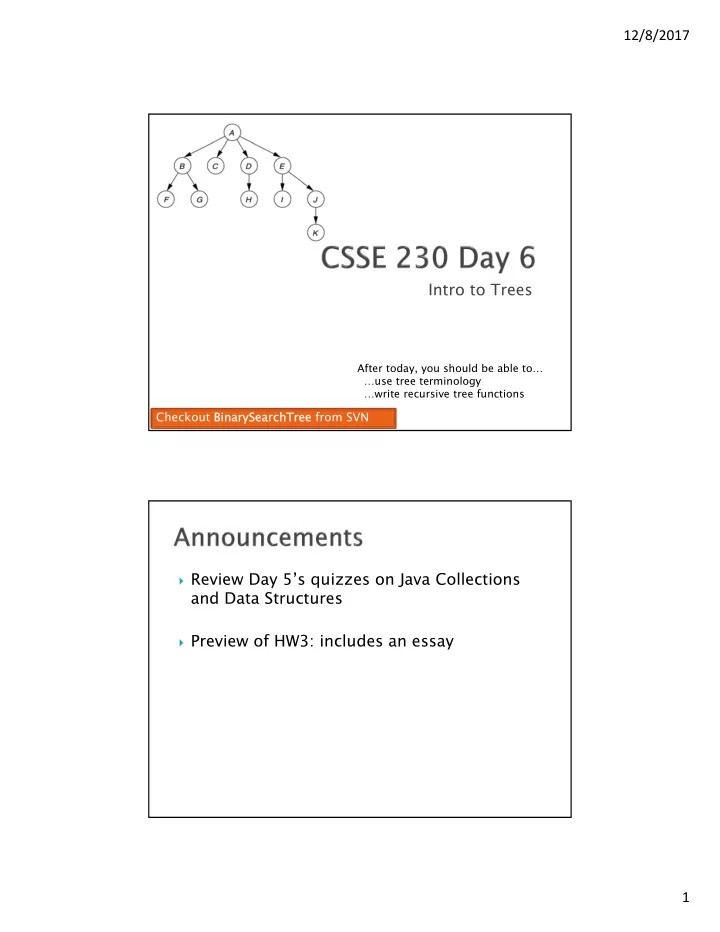

12/8/2017 Intro to Trees After today, you should be able to… …use tree terminology …write recursive tree functions Checkout Bina narySea rySearchTree chTree from SVN Review Day 5’s quizzes on Java Collections and Data Structures Preview of HW3: includes an essay 1
12/8/2017 It must be O(n), so you can’t grow your strings character-by-character: ◦ Strings are immutable, so characters must be copied. s += “*” is as slow growing an array using the +1 scheme Solution? Use a StringBuilder! ◦ They have internal capacity, which doubles when full! See the example at the end of Warmup and Stretching’s ShapeText.java for an example. 1 Exam 1 – Day 8: 7-9 pm ◦ Coverage: Everything from reading and lectures, Sessions 1-7 Programs: Warmup, Stacks and Queues Homeworks 1-2 ◦ Allowed resources: Written part: ½ of one side of 8.5 x 11 paper Goal: to let you use formulas but force you to summarize. Programming part: Textbook Eclipse (including programs you wrote in your repos) Course web pages and materials on Moodle Java API documentation Two previous 230 Exam 1’s are available in Moodle 2
12/8/2017 ◦ Written (50-70%): Growable Arrays MCSS big O/ / : true/false, using definitions, limits, code analysis Binary search ADT/Collections Choosing an ADT to solve a given problem ◦ Programming (30-50%): Implementing an ADT using an array, nodes, or another ADT Writing an efficient algorithm to solve a simple array-based problem 3
12/8/2017 an implementation that offers interesting benefits, but is more complex to code than arrays or lists… … Trees! Introduction and terminology for three types Trees Binary Trees Binary Search Trees ? 4
12/8/2017 Class hierarchy tree (single inheritance only) Directory tree in a file system 5
12/8/2017 A collection of nodes Nodes are connected by directed edges. ◦ One special root node has no incoming edges ◦ All other nodes have exactly one incoming edge One way that Computer Scientists are odd is that our trees usually have their root at the top! How are trees like a linked list? How are they different? Q1, 2 Q1, 2 Parent Child Grandparent Sibling Ancestors and descendants Proper ancestors, proper descendants Subtree Leaf, interior node Depth and height of a node Height of a tree 6
12/8/2017 Q3-6 Q3-6 The height of height of a tree a tree is the height of its root node. Which is larger, the sum of the heights or the sum of the depths of all nodes in a tree? A Binary Binary Tree is either ◦ empty empty, or ◦ consi consists ts of: a distinguished node called the root, which contains an element, and A left subtree T L , which is a binary tree root A right subtree T R , which is a binary tree Binary Binary trees contain at most 2 children T L T R 7
12/8/2017 Q7-9 Q7-9 Q: What property enables us to search BSTs efficiently? A: Every element in the left subtree is smaller than the root, and every element in the right subtree is larger than the root. And this is true at every node every node, not just the root. Write size() for linked list ◦ Non-recursively ◦ Recursively Write size() for a tree ◦ Recursively ◦ Non-recursively (later) 8
12/8/2017 Let’s start the BinarySearchTrees assignment: implement a BinaryTree<T> class Test tree: A single tiny recursive method for 1 size will touch ev every node in node in the the tree tree. 4 2 Let’s write, then watch in debugger. 5 3 6 9
Recommend
More recommend